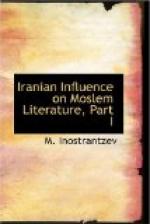HAMZA ISPAHANI.
[Sidenote: Why no authentic history of Iran has survived.]
[Sidenote: A clear reference to the ambiguous Pahlavi script and to the great difficulty of translating from it:]
[Sidenote: Enumeration of the sources of Iranian history.]
There are four dynasties among the kings of Persia and their enumeration is given alone and without any history of the events of their time or the characteristics of the kings of Persia during the protracted period of their sovereignty. They were divided into four groups called the Feshdadiya, the Kayaniya, the Ashghaniya, and the Sasaniya. Their entire chronology is dubious and not certain since it was translated after 150 years from one language into another and from one equivocal set of symbols for figures into another set of symbols, so that there remained nothing for me with reference to a narrative, in these chapters except to bring together the doubtful transcripts. I succeeded in finding eight transcripts and these were the following:—The Book of the Reigns of the Kings of Persia translated by Ibn al Mukaffa, the Book of the Reigns of the Kings of Persia translated by Muhammad Ibn al Jaham al Barmak, the Book of the History of the Kings of Persia which was taken out of the treasury of the Khalif Mamun; the Book of the Reigns of the Kings of Persia which was translated by Zaduya son of Shahuya of Ispahan; the Book of the Reigns of the Kings of Persia which was translated or compiled by Muhammad Ibn al Behram Ibn Mutyan of Ispahan; the Book of the Chronology of the Kings of Persia which was translated or compiled by Heshan Ibn Kasum of Ispahan, the Book of the Chronology of the Kings of the Sasanian Dynasty which was improved upon by Behram son of Mardan Shah, Mobed of the district of Shabur in the country of Fars. And when I had collected together all these works, I compared one with the others and then acquired what was necessary for the writing of this chapter.
[Sidenote: Incorrect translations from Pahlavi.]
And says Abu Mashar, the astronomer:—The majority of their [Iranian] histories are interpolated and corrupt, and there is the corruption because they have come down from a great many years ago and because they have been translated from one writing into another and from one tongue into another and hence there have been mistakes of either excess or defect.
“And the Persians start their assertion from the Book which was brought to them by Zaradusht and which was called Avesta. This is the Book of their religion. It alleges that there have elapsed since the reign of Kayumarth, the father of mankind, down to the reign of king Yazdegerd, 4182 years, 10 months, and 19 days.”




